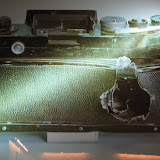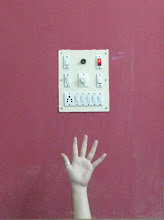Saigon failed to charm either of us in the way that Hanoi had done, but that's not to say we didn't like it, its just that we both particularly fell for Hanoi. Like most of Vietnam you can't fail to eat incredibly well wherever you go and Saigon didn't let the side down. Once again, we found ourselves spending large portions of our time on street stalls in the evenings and having long lunches in back alley restaurants, where you could dine on plates of superb shellfish, eel cooked in Bamboo tubes and amazing noodle soups all washed down with cheap beer or some half decent chilled wine. We were also lucky enough to have found ourselves an excellent budget pad on the top floor of a building off the main drag with an entire roof terrace to ourselves. OK, so it was up nine flights of stairs, with no lift, and come six thirty seemed to be home to half the bats in Saigon, but it was good to have some respite from the heat and craziness of the city below.
Culturally and historically, Saigon was also fascinating and we were keen to use our time there to learn more about Vietnams long history of conflicts, the war with the US for me having the most relevance being brought up on a diet of 'Nam action films and references. So we donned our touron badges and piled on the bus with the middle aged Germans and took a couple of excursions to check out the sites (hiring a moped would have been tantamount to suicide...). As it happened the tours were really well organised and properly informative. We first visited Cu Chi - a couple of hours outside the city and home to the notorious VC Tunnels.
Now, if you don't know much about these, they are the huge network of tiny underground tunnels that the rural Viet Cong dug and lived in for years and used to outwit the US military in the region. Besides the total remarkabilty of anyone being able to live solely in dark, cramped, boiling claustrophobic holes and caves for years on end, barely ever emerging to daylight, the sheer ingenuity of their tricks and traps is overwhelming. Faced with the worlds most advanced and well funded military, they used only their knowledge of the land and what they had to hand in the jungle to scare the living crap out of the invaders. Lethal traps were set everywhere that were basically invisible to the US soldiers, and tiny trapdoors that could only accommodate the small frames of the VC would fly silently open in the ground, enabling them to stealthily take out soldiers - the enemy paralysed by fear and unable to work out where fire was coming from. As the guide told us, many US soldiers later claimed that they felt like they were under attack from ghosts. In addition, they used tactics like rubbing US military soap (that troops had carelessly thrown away) around entrances to dens to throw the army's dogs off the scent - being familiar with the smell of it on their US troops they padded on. They also learned to cook underground, making small kitchens that they only used in the early hours of sunrise when the jungle was covered with mist so no smoke could be detected.
There is no doubt that what happened in the jungle there was horrific and while both sides inflicted terrible fatalities on each other, you can't help have a sense of respect for a simple rural people, who, faced with a far superior military might, still managed to outwit the enemy with nothing but guile and basic hardcore determination. We both did the long crawl down one of the tunnels in the dark (which were actually made bigger for westerners to get their bulky bodies down) and I can tell you that it is far from pleasant. The idea of living in one for years, facing the potential of being bombed or shot every day must have been a grim way to live, although it was pretty amusing to watch a rather unpleasant overweight Bermuda-clad French couple emerge from the hole at the end looking like they were going to need CPR. Cruel but funny.
During the afternoon we visited the War Remembrance Museum, and if the tunnels weren't reminder enough of the trauma of war, then this was a real kick in the head. The full scale of the horror of the damage done was laid out in graphic photographs, models, and piles of armaments. Quotes from brain dead soldiers and shocking news reports accompanied the images - the scale of the US brutality toward the Vietnamese (and Cambodians) was almost incomprehensible and shows up politicians like Kissinger and Nixon for the absolute excuses for humans beings that they really were. Worst of all were the sections on Agent Orange - it's not often you can hear people audibly gasping in public museums. Its testament to the nature of the Vietnamese that little over thirty five years after such appalling crimes were committed (some of which you can still often see on the bodies of men in the street), that they've open their arms to the US and have managed to successfully move on.
The rest of the day took in the slightly bizarre Independence Palace, which reminded me of a cross between a seventies Corbusier designed college faculty building and the lair of one of James Bond's nemeses; the interior being decorated in a totally un-ironic kitsch retro style, with a games room and even a dance floor with bar on the roof. Down below in the basement lay a catacomb of somewhat sinister telecommunications cells and an operations centre complete with giant maps dotted with pins showing territories lost and won. Doctor Strangelove came to mind - "You can't fight in here! This is the War Room!".
We left Saigon after four interesting days headed for the mighty Mekong Delta, somewhere I'd always wanted to see. Unfortunately the trip this time included a fairly artificial representation of life on the Mekong, being dragged round "working villages" to "see villagers go about their daily lives" (alarms bells always ring when this phrase is used...). Can I also say that while over the amazing month we travelled Vietnam, we came to love many aspects of the culture, but folk music is not one of their strong points - think stray cats and out of tune violins. Luckily for us the scenery and company were excellent, and we met our new travel bud for the next crazy and slightly messy week - Mr Mike Beatty from San Francisco.
After a night stop over in a small delta town, we headed out at sunrise for the second part of the trip, the floating fishing villages, and then onto the badass of a journey that would take us all the way over the border and into the heart of Cambodia - nine hours on a slow boat up the Mekong. If you think you've ever been hot before, then think again, nine hours in one hundred degree heat, sat on the stinking dirty engine of a small dilapidated river boat squashed in with thirty other people is HOT. Thank god for endless cold beer and Californian positivity...
View our pics here:
 |
| Saigon, The Mekong Delta and Slow Boat to Cambodia |

No comments:
Post a Comment